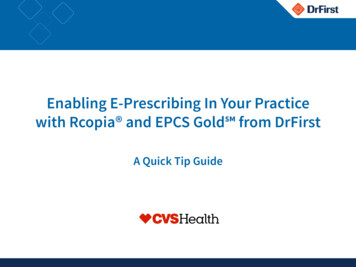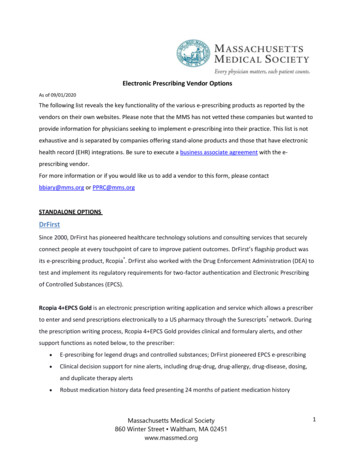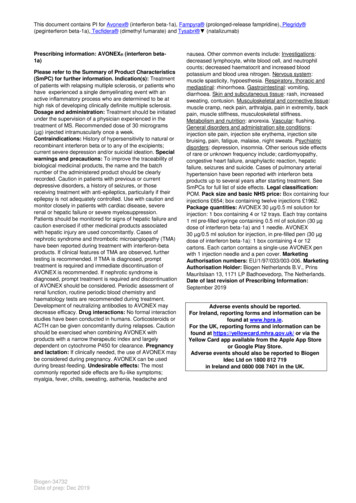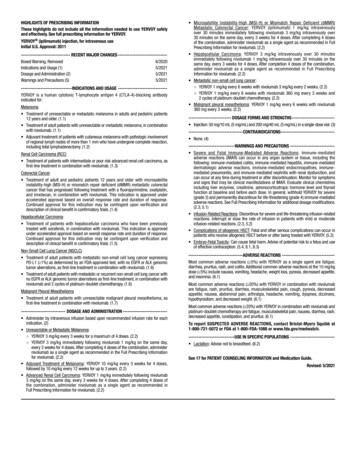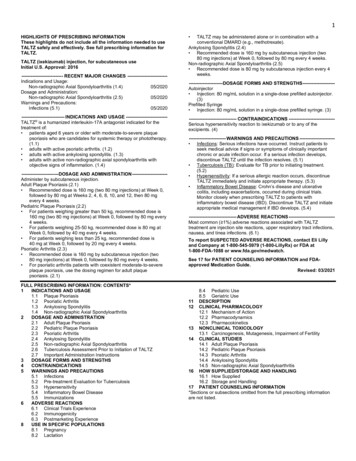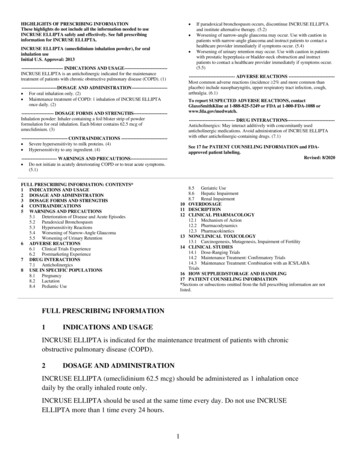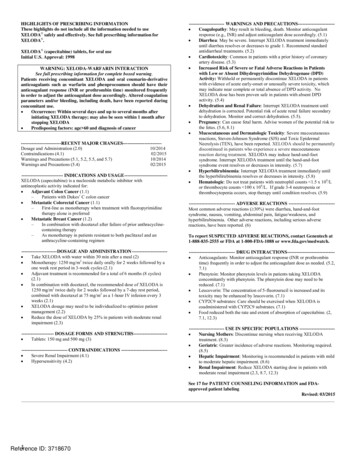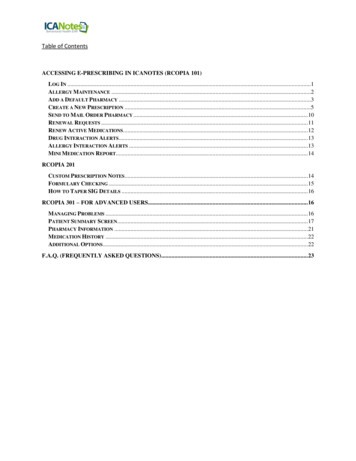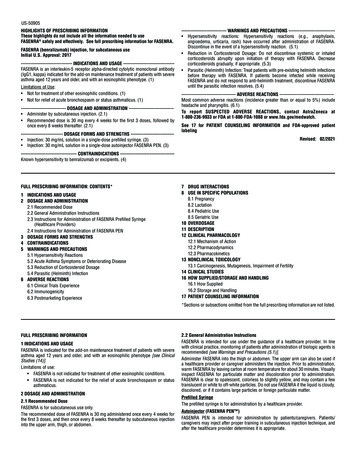
Transcription
US-50905HIGHLIGHTS OF PRESCRIBING INFORMATIONThese highlights do not include all the information needed to useFASENRA safely and effectively. See full prescribing information for FASENRA.FASENRA (benralizumab) injection, for subcutaneous useInitial U.S. Approval: 2017--------------------------------- INDICATIONS AND USAGE --------------------------------FASENRA is an interleukin-5 receptor alpha-directed cytolytic monoclonal antibody(IgG1, kappa) indicated for the add-on maintenance treatment of patients with severeasthma aged 12 years and older, and with an eosinophilic phenotype. (1)Limitations of Use: Not for treatment of other eosinophilic conditions. (1) Not for relief of acute bronchospasm or status asthmaticus. (1)----------------------------- DOSAGE AND ADMINISTRATION ---------------------------- Administer by subcutaneous injection. (2.1) Recommended dose is 30 mg every 4 weeks for the first 3 doses, followed byonce every 8 weeks thereafter. (2.1)--------------------------- DOSAGE FORMS AND STRENGTHS --------------------------- Injection: 30 mg/mL solution in a single-dose prefilled syringe. (3) Injection: 30 mg/mL solution in a single-dose autoinjector FASENRA PEN. (3)----------------------------- WARNINGS AND PRECAUTIONS ----------------------------- Hypersensitivity reactions: Hypersensitivity reactions (e.g., anaphylaxis,angioedema, urticaria, rash) have occurred after administration of FASENRA.Discontinue in the event of a hypersensitivity reaction. (5.1) Reduction in Corticosteroid Dosage: Do not discontinue systemic or inhaledcorticosteroids abruptly upon initiation of therapy with FASENRA. Decreasecorticosteroids gradually, if appropriate. (5.3) Parasitic (Helminth) Infection: Treat patients with pre-existing helminth infectionsbefore therapy with FASENRA. If patients become infected while receivingFASENRA and do not respond to anti-helminth treatment, discontinue FASENRAuntil the parasitic infection resolves. (5.4)----------------------------------- ADVERSE REACTIONS ----------------------------------Most common adverse reactions (incidence greater than or equal to 5%) includeheadache and pharyngitis. (6.1)To report SUSPECTED ADVERSE REACTIONS, contact AstraZeneca at1-800-236-9933 or FDA at 1-800-FDA-1088 or www.fda.gov/medwatch.See 17 for PATIENT COUNSELING INFORMATION and FDA-approved patientlabelingRevised: 02/2021------------------------------------ CONTRAINDICATIONS ----------------------------------Known hypersensitivity to benralizumab or excipients. (4)FULL PRESCRIBING INFORMATION: CONTENTS*1 INDICATIONS AND USAGE2 DOSAGE AND ADMINISTRATION2.1 Recommended Dose2.2 General Administration Instructions2.3 Instructions for Administration of FASENRA Prefilled Syringe(Healthcare Providers)2.4 Instructions for Administration of FASENRA PEN3 DOSAGE FORMS AND STRENGTHS4 CONTRAINDICATIONS5 WARNINGS AND PRECAUTIONS5.1 Hypersensitivity Reactions5.2 Acute Asthma Symptoms or Deteriorating Disease5.3 Reduction of Corticosteroid Dosage5.4 Parasitic (Helminth) Infection6 ADVERSE REACTIONS6.1 Clinical Trials Experience6.2 Immunogenicity6.3 Postmarketing Experience7 DRUG INTERACTIONS8 USE IN SPECIFIC POPULATIONS8.1 Pregnancy8.2 Lactation8.4 Pediatric Use8.5 Geriatric Use10 OVERDOSAGE11 DESCRIPTION12 CLINICAL PHARMACOLOGY12.1 Mechanism of Action12.2 Pharmacodynamics12.3 Pharmacokinetics13 NONCLINICAL TOXICOLOGY13.1 Carcinogenesis, Mutagenesis, Impairment of Fertility14 CLINICAL STUDIES16 HOW SUPPLIED/STORAGE AND HANDLING16.1 How Supplied16.2 Storage and Handling17 PATIENT COUNSELING INFORMATION*Sections or subsections omitted from the full prescribing information are not listed.FULL PRESCRIBING INFORMATION1 INDICATIONS AND USAGEFASENRA is indicated for the add-on maintenance treatment of patients with severeasthma aged 12 years and older, and with an eosinophilic phenotype [see ClinicalStudies (14)].Limitations of use: FASENRA is not indicated for treatment of other eosinophilic conditions. FASENRA is not indicated for the relief of acute bronchospasm or statusasthmaticus.2 DOSAGE AND ADMINISTRATION2.1 Recommended DoseFASENRA is for subcutaneous use only.The recommended dose of FASENRA is 30 mg administered once every 4 weeks forthe first 3 doses, and then once every 8 weeks thereafter by subcutaneous injectioninto the upper arm, thigh, or abdomen.2.2 General Administration InstructionsFASENRA is intended for use under the guidance of a healthcare provider. In linewith clinical practice, monitoring of patients after administration of biologic agents isrecommended [see Warnings and Precautions (5.1)].Administer FASENRA into the thigh or abdomen. The upper arm can also be used ifa healthcare provider or caregiver administers the injection. Prior to administration,warm FASENRA by leaving carton at room temperature for about 30 minutes. Visuallyinspect FASENRA for particulate matter and discoloration prior to administration.FASENRA is clear to opalescent, colorless to slightly yellow, and may contain a fewtranslucent or white to off-white particles. Do not use FASENRA if the liquid is cloudy,discolored, or if it contains large particles or foreign particulate matter.Prefilled SyringeThe prefilled syringe is for administration by a healthcare provider.Autoinjector (FASENRA PEN )FASENRA PEN is intended for administration by patients/caregivers. Patients/caregivers may inject after proper training in subcutaneous injection technique, andafter the healthcare provider determines it is appropriate.
FASENRA (benralizumab) injection, for subcutaneous use2.3 Instructions for Administration of FASENRA Prefilled Syringe (HealthcareProviders)Refer to Figure 1 to identify the prefilled syringe components for use in theadministration steps.Figure 1Needle guardactivation clipsSyringebodyLabel withexpiration dateNeedle cover23 DOSAGE FORMS AND STRENGTHSFASENRA is a clear to opalescent, colorless to slightly yellow solution and maycontain a few translucent or white to off-white particles. Injection: 30 mg/mL solution in a single-dose prefilled syringe. Injection: 30 mg/mL solution in a single-dose autoinjector FASENRA PEN.4 CONTRAINDICATIONSFASENRA is contraindicated in patients who have known hypersensitivity tobenralizumab or any of its excipients [see Warnings and Precautions (5.1)].5 WARNINGS AND PRECAUTIONS5.1 Hypersensitivity ReactionsHypersensitivity reactions (e.g., anaphylaxis, angioedema, urticaria, rash) haveoccurred following administration of FASENRA. These reactions generally occurwithin hours of administration, but in some instances have a delayed onset (i.e.,days). In the event of a hypersensitivity reaction, FASENRA should be discontinued[see Contraindications edleDo not touch the needle guard activation clips to prevent premature activation ofthe needle safety guard.1 Grasp the syringe body, not the plunger, to remove prefilled syringe from theexpiration date on the syringe. The syringe may contain small airnormal. Do not expel the air bubbles prior to administration.tray. Check theNEEDLE GUARDWINGS bubbles; this is2345Do not remove needle cover until ready toinject. Hold the syringe body and removethe needle cover by pulling straight off.Do not hold the plunger or plunger headwhile removing the needle cover or theplunger may move. If the prefilled syringeis damaged or contaminated (for example,dropped without needle cover in place),discard and use a new prefilled syringe.Gently pinch the skin and insert the needleat the recommended injection site(i.e., upper arm, thigh, or abdomen).Inject all of the medication by pushing inthe plunger all the way until the plungerhead is completely between the needleguard activation clips. This is necessaryto activate the needle guard.After injection, maintain pressure on theplunger head and remove the needle fromthe skin. Release pressure on the plungerhead to allow the needle guard to cover theneedle. Do not re-cap the prefilled syringe.6 Discard the used syringe into a sharps container.2.4 Instructions for Administration of FASENRA PENRefer to the FASENRA PEN ‘Instructions for Use’ for more detailed instructions onthe preparation and administration of FASENRA PEN [See Instructions for Use].A patient may self-inject or the patient caregiver may administer FASENRA PENsubcutaneously after the healthcare provider determines it is appropriate.5.2 Acute Asthma Symptoms or Deteriorating DiseaseFASENRA should not be used to treat acute asthma symptoms or acute exacerbations.Do not use FASENRA to treat acute bronchospasm or status asthmaticus. Patientsshould seek medical advice if their asthma remains uncontrolled or worsens afterinitiation of treatment with FASENRA.5.3 Reduction of Corticosteroid DosageDo not discontinue systemic or inhaled corticosteroids abruptly upon initiation oftherapy with FASENRA. Reductions in corticosteroid dose, if appropriate, should begradual and performed under the direct supervision of a physician. Reduction incorticosteroid dose may be associated with systemic withdrawal symptoms and/orunmask conditions previously suppressed by systemic corticosteroid therapy.5.4 Parasitic (Helminth) InfectionEosinophils may be involved in the immunological response to some helminthinfections. Patients with known helminth infections were excluded from participationin clinical trials. It is unknown if FASENRA will influence a patient’s response againsthelminth infections.Treat patients with pre-existing helminth infections before initiating therapy withFASENRA. If patients become infected while receiving treatment with FASENRA anddo not respond to anti-helminth treatment, discontinue treatment with FASENRAuntil infection resolves.6 ADVERSE REACTIONSThe following adverse reactions are described in greater detail in other sections: Hypersensitivity Reactions [see Warnings and Precautions (5.1)]6.1 Clinical Trials ExperienceBecause clinical trials are conducted under widely varying conditions, adversereaction rates observed in the clinical trials of a drug cannot be directly comparedto rates in the clinical trials of another drug and may not reflect the rates observedin practice.Across Trials 1, 2, and 3, 1,808 patients received at least 1 dose of FASENRA [seeClinical Studies (14)]. The data described below reflect exposure to FASENRA in1,663 patients, including 1,556 exposed for at least 24 weeks and 1,387 exposedfor at least 48 weeks. The safety exposure for FASENRA is derived from twoPhase 3 placebo-controlled studies (Trials 1 and 2) from 48 weeks duration[FASENRA every 4 weeks (n 841), FASENRA every 4 weeks for 3 doses, then every8 weeks (n 822), and placebo (n 847)]. While a dosing regimen of FASENRA every4 weeks was included in clinical trials, FASENRA administered every 4 weeks for3 doses, then every 8 weeks thereafter is the recommended dose [see Dosage andAdministration (2.1)]. The population studied was 12 to 75 years of age, of which64% were female and 79% were white.Adverse reactions that occurred at greater than or equal to 3% incidence are shownin Table 1.Table 1. Adverse Reactions with FASENRA with Greater than or Equal to 3%Incidence in Patients with Asthma (Trials 1 and 2)Adverse ty reactions†FASENRA(N 822)%8353Placebo(N 847)%6233*Pharyngitis was defined by the following terms: ‘Pharyngitis’, ‘Pharyngitis bacterial’, ‘Viralpharyngitis’, ‘Pharyngitis streptococcal’.†Hypersensitivity Reactions were defined by the following terms: ‘Urticaria’, ‘Urticaria papular’,and ‘Rash’ [see Warnings and Precautions (5.1)].
FASENRA (benralizumab) injection, for subcutaneous use28-Week TrialAdverse reactions from Trial 3 with 28 weeks of treatment with FASENRA (n 73)or placebo (n 75) in which the incidence was more common in FASENRA thanplacebo include headache (8.2% compared to 5.3%, respectively) and pyrexia (2.7%compared to 1.3%, respectively) [see Clinical Studies (14)]. The frequencies for theremaining adverse reactions with FASENRA were similar to placebo.Injection site reactionsIn Trials 1 and 2, injection site reactions (e.g., pain, erythema, pruritus, papule)occurred at a rate of 2.2% in patients treated with FASENRA compared with 1.9% inpatients treated with placebo.6.2 ImmunogenicityAs with all therapeutic proteins, there is potential for immunogenicity. The detectionof antibody formation is highly dependent on the sensitivity and specificity of theassay. Additionally, the observed incidence of antibody (including neutralizingantibody) positivity in an assay may be influenced by several factors includingassay methodology, sample handling, timing of sample collection, concomitantmedications, and underlying disease. For these reasons, comparison of the incidenceof antibodies to benralizumab in the studies described below with the incidence ofantibodies in other studies or to other products may be misleading.Overall, treatment-emergent anti-drug antibody response developed in 13% ofpatients treated with FASENRA at the recommended dosing regimen during the 48 to56 week treatment period. A total of 12% of patients treated with FASENRA developedneutralizing antibodies. Anti-benralizumab antibodies were associated with increasedclearance of benralizumab and increased blood eosinophil levels in patients with highanti-drug antibody titers compared to antibody negative patients. No evidence of anassociation of anti-drug antibodies with efficacy or safety was observed.The data reflect the percentage of patients whose test results were positive forantibodies to benralizumab in specific assays.6.3 Postmarketing ExperienceIn addition to adverse reactions reported from clinical trials, the following adversereactions have been identified during post approval use of FASENRA. Becausethese reactions are reported voluntarily from a population of uncertain size, it is notalways possible to reliably estimate their frequency or establish a causal relationshipto drug exposure. These events have been chosen for inclusion due to eithertheir seriousness, frequency of reporting, or causal connection to FASENRA or acombination of these factors.Immune System Disorders: Hypersensitivity reactions, including anaphylaxis.7 DRUG INTERACTIONSNo formal drug interaction studies have been conducted.8 USE IN SPECIFIC POPULATIONS8.1 PregnancyPregnancy Exposure RegistryThere is a pregnancy exposure registry that monitors pregnancy outcomes in womenexposed to FASENRA during pregnancy. Healthcare providers can enroll patientsor encourage patients to enroll themselves by calling 1-877-311-8972 or visitingmothertobaby.org/Fasenra.Risk SummaryThe data on pregnancy exposure from the clinical trials are insufficient to inform ondrug-associated risk. Monoclonal antibodies such as benralizumab are transportedacross the placenta during the third trimester of pregnancy; therefore, potentialeffects on a fetus are likely to be greater during the third trimester of pregnancy. In aprenatal and postnatal development study conducted in cynomolgus monkeys, therewas no evidence of fetal harm with IV administration of benralizumab throughoutpregnancy at doses that produced exposures up to approximately 310 times theexposure at the maximum recommended human dose (MRHD) of 30 mg SC[see Data].In the U.S. general population, the estimated background risk of major birth defectsand miscarriage in clinically recognized pregnancies is 2% to 4% and 15% to 20%,respectively.Clinical ConsiderationsDisease-associated maternal and/or embryo/fetal risk:In women with poorly or moderately controlled asthma, evidence demonstrates thatthere is an increased risk of preeclampsia in the mother and prematurity, low birthweight, and small for gestational age in the neonate. The level of asthma controlshould be closely monitored in pregnant women and treatment adjusted as necessaryto maintain optimal control.DataAnimal DataIn a prenatal and postnatal development study, pregnant cynomolgus monkeysreceived benralizumab from beginning on GD20 to GD22 (dependent on pregnancy3determination), on GD35, once every 14 days thereafter throughout the gestationperiod and 1-month postpartum (maximum 14 doses) at doses that producedexposures up to approximately 310 times that achieved with the MRHD (on an AUCbasis with maternal IV doses up to 30 mg/kg once every 2 weeks). Benralizumab didnot elicit adverse effects on fetal or neonatal growth (including immune function)up to 6.5 months after birth. There was no evidence of treatment-related external,visceral, or skeletal malformations. Benralizumab was not teratogenic in cynomolgusmonkeys. Benralizumab crossed the placenta in cynomolgus monkeys. Benralizumabconcentrations were approximately equal in mothers and infants on postpartumday 7, but were lower in infants at later time points. Eosinophil counts weresuppressed in infant monkeys with gradual recovery by 6 months postpartum;however, recovery of eosinophil counts was not observed for one infant monkeyduring this period.8.2 LactationRisk SummaryThere is no information regarding the presence of benralizumab in human or animalmilk, and the effects of benralizumab on the breast fed infant and on milk productionare not known. However, benralizumab is a humanized monoclonal antibody(IgG1/κ-class), and immunoglobulin G (IgG) is present in human milk in smallamounts. If benralizumab is transferred into human milk, the effects of local exposurein the gastrointestinal tract and potential limited systemic exposure in the infant tobenralizumab are unknown. The developmental and health benefits of breastfeedingshould be considered along with the mother’s clinical need for benralizumab andany potential adverse effects on the breast-fed child from benralizumab or from theunderlying maternal condition.8.4 Pediatric UseThere were 108 adolescents aged 12 to 17 with asthma enrolled in the Phase 3exacerbation trials (Trial 1: n 53, Trial 2: n 55). Of these, 46 received placebo, 40received FASENRA every 4 weeks for 3 doses, followed by every 8 weeks thereafter,and 22 received FASENRA every 4 weeks. Patients were required to have a history of2 or more asthma exacerbations requiring oral or systemic corticosteroid treatmentin the past 12 months and reduced lung function at baseline (pre-bronchodilatorFEV1 90%) despite regular treatment with medium or high dose ICS and LABA withor without OCS or other controller therapy. The pharmacokinetics of benralizumab inadolescents 12 to 17 years of age were consistent with adults based on populationpharmacokinetic analysis and the reduction in blood eosinophil counts was similarto that observed in adults following the same FASENRA treatment. The adverse eventprofile in adolescents was generally similar to the overall population in the Phase 3studies [see Adverse Reactions (6.1)]. The safety and efficacy in patients youngerthan 12 years of age has not been established.8.5 Geriatric UseOf the total number of patients in clinical trials of benralizumab, 13% (n 320) were65 and over, while 0.4% (n 9) were 75 and over. No overall differences in safety oreffectiveness were observed between these patients and younger patients, and otherreported clinical experience has not identified differences in responses between theelderly and younger patients, but greater sensitivity of some older individuals cannotbe ruled out.10 OVERDOSAGEDoses up to 200 mg were administered subcutaneously in clinical trials to patientswith eosinophilic disease without evidence of dose-related toxicities.There is no specific treatment for an overdose with benralizumab. If overdose occurs,the patient should be treated supportively with appropriate monitoring as necessary.11 DESCRIPTIONBenralizumab is a humanized monoclonal antibody (IgG1/κ-class) selective forinterleukin-5 receptor alpha subunit (IL-5Rα). Benralizumab is produced in Chinesehamster ovary cells by recombinant DNA technology. Benralizumab has a molecularweight of approximately 150 kDa.FASENRA (benralizumab) injection is a sterile, preservative-free, clear to opalescent,colorless to slightly yellow solution for subcutaneous injection. Since benralizumabis a protein, a few translucent or white to off-white particles may be present in thesolution. Each single-dose prefilled syringe or single-dose autoinjector delivers1 mL containing 30 mg benralizumab, L-histidine (1.4 mg); L-histidine hydrochloridemonohydrate (2.3 mg); polysorbate 20 (0.06 mg); α,α-trehalose dihydrate (95 mg);and Water for Injection, USP. The single-dose prefilled syringe or single-doseautoinjector contains a 1 mL glass syringe with a staked 29 gauge ½ inch stainlesssteel needle.12 CLINICAL PHARMACOLOGY12.1 Mechanism of ActionBenralizumab is a humanized afucosylated, monoclonal antibody (IgG1, kappa) thatdirectly binds to the alpha subunit of the human interleukin-5 receptor (IL-5Rα) witha dissociation constant of 11 pM. The IL-5 receptor is expressed on the surfaceof eosinophils and basophils. In an in vitro setting, the absence of fucose in theFc domain of benralizumab facilitates binding (45.5 nM) to FcɣRIII receptors on
FASENRA (benralizumab) injection, for subcutaneous useimmune effector cells, such as natural killer (NK) cells, leading to apoptosis ofeosinophils and basophils through antibody-dependent cell-mediated cytotoxicity(ADCC).Inflammation is an important component in the pathogenesis of asthma. Multiplecell types (e.g., mast cells, eosinophils, neutrophils, macrophages, lymphocytes)and mediators (e.g., histamine, eicosanoids, leukotrienes, cytokines) are involvedin inflammation. Benralizumab, by binding to the IL-5Rα chain, reduces eosinophilsthrough ADCC; however, the mechanism of benralizumab action in asthma has notbeen definitively established.12.2 PharmacodynamicsIn the 52-week Phase 2 dose-ranging trial, asthma patients received 1 of 3 doses ofbenralizumab [2 mg (n 81), 20 mg (n 81), or 100 mg (n 222)] or placebo (n 222).All doses were administered every 4 weeks for the first 3 doses, followed by every8 weeks thereafter. Median blood eosinophil levels at baseline were 310, 280,190 and 190 cells/μL in the 2, 20, and 100 mg benralizumab and placebo groups,respectively. Dose-dependent reductions in blood eosinophils were observed. At thetime of the last dose (Week 40), median blood eosinophil counts were 100, 50, 40,170 cells/μL in the 2, 20, and 100 mg benralizumab and placebo groups, respectively.A reduction in blood eosinophil counts was observed 24 hours post dosing in aPhase 2 trial.In Trials 1 and 2, following SC administration of benralizumab at the recommendeddose blood eosinophils were reduced to a median absolute blood eosinophil countof 0 cells/μL [see Clinical Studies (14)]. This magnitude of reduction was seen at thefirst observed time point, 4 weeks of treatment, and was maintained throughout thetreatment period.Treatment with benralizumab was also associated with reductions in blood basophils,which was consistently observed across all clinical studies. In the Phase 2 doseranging trial, blood basophil counts were measured by flow cytometry. Median bloodbasophil counts were 45, 52, 46, and 40 cells/μL in the 2 mg, 20 mg and 100 mgbenralizumab and placebo groups, respectively. At 52 weeks (12 weeks after the lastdose), median blood basophil counts were 42, 18, 17, and 46 cells/μL in the 2 mg,20 mg and 100 mg benralizumab and placebo groups, respectively.12.3 PharmacokineticsThe pharmacokinetics of benralizumab was approximately dose-proportional inpatients with asthma following subcutaneous administration over a dose range of20 to 200 mg.AbsorptionFollowing subcutaneous administration to patients with asthma, the absorptionhalf-life was approximately 3.5 days. Based on population pharmacokinetic analysis,the estimated absolute bioavailability was approximately 59% and there was noclinically relevant difference in relative bioavailability in the administration to theabdomen, thigh, or arm.Distribution:Based on population pharmacokinetic analysis, central and peripheral volume ofdistribution of benralizumab was 3.1 L and 2.5 L, respectively, for a 70 kg individual.Metabolism:Benralizumab is a humanized IgG1 monoclonal antibody that is degradedby proteolytic enzymes widely distributed in the body and not restricted tohepatic tissue.Elimination:From population pharmacokinetic analysis, benralizumab exhibited linearpharmacokinetics and no evidence of target receptor-mediated clearance pathway.The estimated typical systemic clearance (CL) for benralizumab was 0.29 L/d fora subject weighing 70kg. Following subcutaneous administration, the eliminationhalf-life was approximately 15.5 days.Specific populations:Age:Based on population pharmacokinetic analysis, age did not affect benralizumabclearance.Gender, Race:A population pharmacokinetics analysis indicated that there was no significant effectof gender and race on benralizumab clearance.Renal impairment:No formal clinical studies have been conducted to investigate the effect of renalimpairment on benralizumab. Based on population pharmacokinetic analysis,benralizumab clearance was comparable in subjects with creatinine clearance valuesbetween 30 and 80 mL/min and patients with normal renal function. There are limiteddata available in subjects with creatinine clearance values less than 30 mL/min;however, benralizumab is not cleared renally.4Hepatic impairment:No formal clinical studies have been conducted to investigate the effect of hepaticimpairment on benralizumab. IgG monoclonal antibodies are not primarily clearedvia hepatic pathway; change in hepatic function is not expected to influencebenralizumab clearance. Based on population pharmacokinetic analysis, baselinehepatic function biomarkers (ALT, AST, and bilirubin) had no clinically relevant effecton benralizumab clearance.Drug-Drug Interaction:No formal drug-drug interaction studies have been conducted.Cytochrome P450 enzymes, efflux pumps and protein-binding mechanisms are notinvolved in the clearance of benralizumab. There is no evidence of IL-5Rα expressionon hepatocytes and eosinophil depletion does not produce chronic systemicalterations of proinflammatory cytokines.An effect of benralizumab on the pharmacokinetics of co-administered medicationsis not expected. Based on the population analysis, commonly co-administeredmedications had no effect on benralizumab clearance in patients with asthma.13 NONCLINICAL TOXICOLOGY13.1 Carcinogenesis, Mutagenesis, Impairment of FertilityLong-term animal studies have not been performed to evaluate the carcinogenicpotential of benralizumab. Published literature using animal models suggeststhat IL-5 and eosinophils are part of an early inflammatory reaction at the site oftumorigenesis and can promote tumor rejection. However, other reports indicatethat eosinophil infiltration into tumors can promote tumor growth. Therefore,the malignancy risk in humans from an antibody that binds to IL-5Rα such asbenralizumab is unknown.Male and female fertility were unaffected based upon no adverse histopathologicalfindings in the reproductive organs from cynomolgus monkeys treated withbenralizumab for 9 months at IV doses up to 25 mg/kg or at SC doses of up to30 mg/kg once every 2 weeks (approximately 400 and 270 times the MRHD on anAUC basis).14 CLINICAL STUDIESThe asthma development program for FASENRA included one 52-week doseranging exacerbation trial (NCT01238861) three confirmatory trials, (Trial 1[NCT01928771], Trial 2 [NCT01914757], Trial 3 [NCT02075255]) and one 12-weeklung function trial (NCT02322775).Dose-Ranging TrialThe Phase 2 randomized, double-blind, placebo-controlled, 52-week dose-rangingtrial, enrolled 609 asthmatic patients 18 years of age and older. Patients were treatedwith benralizumab 2 mg, 20 mg, or 100 mg or placebo administered subcutaneouslyevery 4 weeks for 3 doses followed by every 8 weeks. The primary endpoint wasthe annual exacerbation rate and forced expiratory volume in 1 second (FEV1) andACQ-6 were key secondary endpoints. Patients were required to have a historyof 2 or more asthma exacerbations (but no more than 6 exacerbations) requiringsystemic corticosteroid treatment in the past 12 months, ACQ-6 score of 1.5at least twice during screening, and reduced morning lung function at screening[pre-bronchodilator FEV1 below 90%] despite treatment with medium- or highdose ICS plus LABA. Patients were stratified by eosinophilic status. The annualexacerbation rate reduction for patients receiving benralizumab 2 mg, 20 mg, and100 mg were -12% (80% CI: -52, 18), 34% (80% CI: 6, 54), 29% (80% CI: 10, 44),respectively, compared to placebo (rate 0.56).Results from this trial and exposure-response modelling of exacerbation ratereduction supported the evaluation of benralizumab 30 mg in the subsequent trials[see Clinical Pharmacology (12.2 and 12.3)]. FASENRA is not approved at 2 mg,20 mg, or 100 mg doses, and should only be administered at the recommended doseof 30 mg [see Dosage and Administration (2.1)].Confirmatory TrialsTrial 1 and Trial 2, were randomized, double-blind, parallel-group, placebo-controlled,exacerbation trials in patients 12 years of age and older and 48 and 56 weeks induration, respectively. The trials randomized a total of 2510 patients. Patients wererequired to have a history of 2 or more asthma exacerbations requiring oral orsystemic corticosteroid treatment in the past 12 months, ACQ-6 score of 1.5 or moreat screening, and reduced lung function at baseline [pre-bronchodilator FEV1 below80% in adults, and below 90% in adolescents] despite regular treatment with highdose inhaled corticosteroid (ICS) (Trial 1) or with medium or high dose ICS (Trial 2)plus a long-acting beta agonist (LABA) with or without oral corticosteroids (OCS)and additional asthma controller medications. Patients were stratified by geography,age, and blood eosinophils count ( 300 cells/μL or 300 cells/μL). FASENRAadministered once every 4 weeks for th
or placebo (n 75) in which the incidence was more common in FASENRA than placebo include headache (8.2% compared to 5.3%, respectively) and pyrexia (2.7% compared to 1.3%, respectively) [see Clinical Studies (14)]. The frequencies for the remaining adverse reactions with FASENRA were similar to placebo. Injection site reactions
